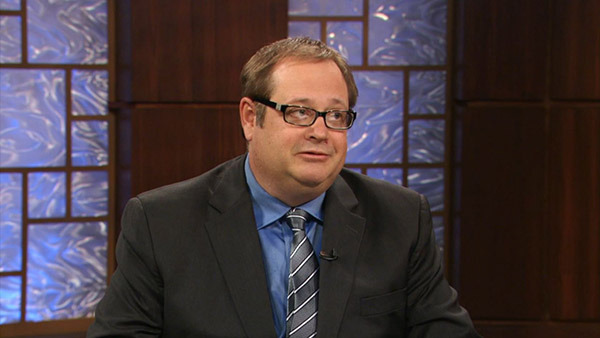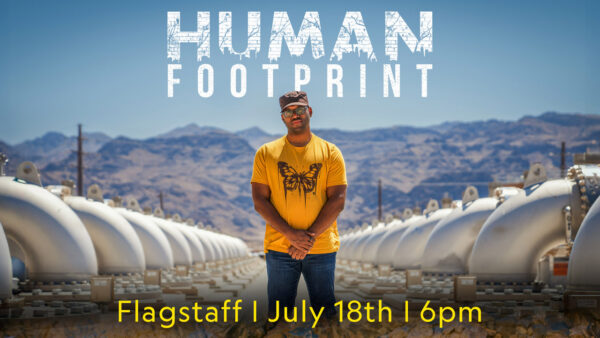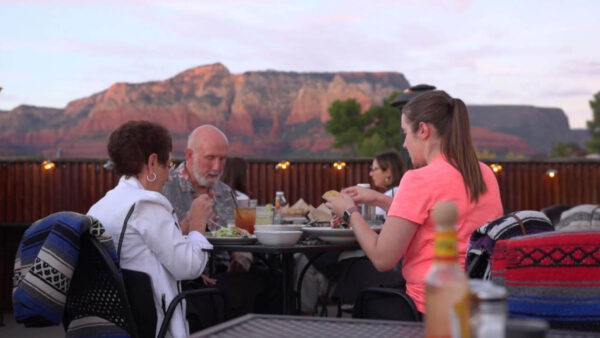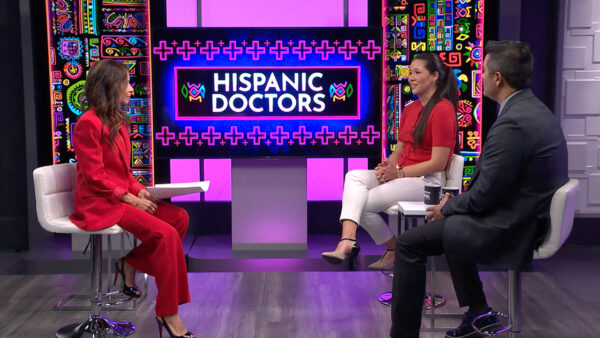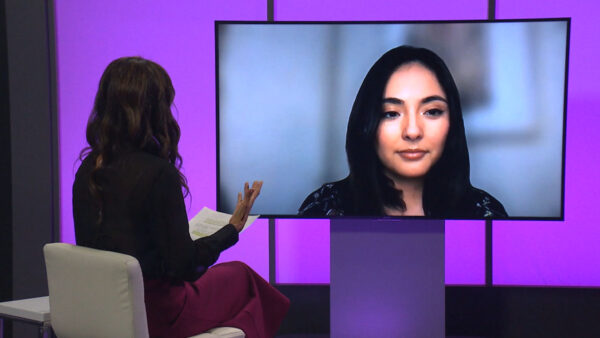Banner Health is working with Maricopa Community Colleges to ease the shortage of qualified health care professionals through a bilingual nursing fellowship program. Guests include Tony Bracamonte, the Associate Dean of enrollment services for South Mountain Community College, and Grace Figuroa of Banner Health.
>>José Cárdenas:
Good evening. Welcome to "HORIZONTE." I'm José Cárdenas. Are U.S. companies bringing more economic growth and success to Mexico? A program to get more Spanish speaking nurses out of the classroom and into the hospitals.
>>José Cárdenas:
U.S. companies are bringing a new investment wave into Mexico, maquiladoras, factories that assemble imported parts for re-export are improving the economy in the streets of Mexico. Joining us to talk about this and the Mexican economy in general is Dawn McLaren, research economist with the ASU Bank One economic outlook center. Dawn, thanks for joining us.
>> Dawn McLaren:
Thank you for having me.
>>José Cárdenas:
Let's talk first about what the ASU Bank One outlook center is.
>> Dawn McLaren:
Well, we are a forecasting branch of the L. William Seedman research institute and we focus on the economies of the western states, on Arizona and we cover Mexico as well.
>>José Cárdenas:
One of the things that the center does is publish this Mexico consensus economic forecast. You're the managing editor. Tell us what the document is.
>> Dawn McLaren:
That is correct. We have a panel of economists in Mexico who contribute each quarter their forecasts for various things including GDP, investment, exports, exchange rates, all sorts of things regarding the economy of Mexico.
>>José Cárdenas:
There are any other kinds of factors you look at when making these prognostications?
>> Dawn McLaren:
We poll them. We basically ask them. They come up with their forecasts whatever method they want to and the panel includes people from major banks, from major investment companies, from consultants and awful that type of inning Mexico. So they're very much in touch with what's happening in the Mexican economy and they make their decisions either through mathematical models or putting in things that they know that they see going on with the political economy and all of that sort of thing.
>>José Cárdenas:
Let's talk a little bit about the Mexican economy. Beginning first with recent history and then tell us what it looks like today.
>> Dawn McLaren:
Yes, well, the Mexican economy has become more and more linked with the U.S. economy. As the U.S. economy fluctuates up and down, so has the Mexican economy been drawn with it? This has happened partially because of N.A.F.T.A., which happened back in 1996, and since then it has been very much tied to it, because even before there was. We've always had a flow of immigrants coming across, for instance, finding work over here and going back. And then with the maquiladora industry coming in, we had a major export market for Mexican companies and then the investment dollars that came from U.S. companies over there that helped really spawn it into something big.
>>José Cárdenas:
I want to get into some of the specifics of what the economy looks like today, but before we get into the specifics, just a general summary of what the Mexican economy is doing right now.
>> Dawn McLaren:
The Mexican economy is doing much better than it was a few years ago. In fact, GDP is expected to grow twice the percentage it was last year and then twice much last year as it was before. So it's been growing in leaps and bounds recently. That's good news and it's good news for workers over there, it's good news for the country, which needs money to be able to continue its social services and all of type of thing. The one part that we haven't seen a great deal of improvement in is in the structure and the corruption factor, which was, of course, going to be addressed by the current administration in Mexico, and I think they've tried but there is still a problem with upholding contracts and all of this type of thing, of robberies on the roads. They just don't have the resources that we do over here to address these issues as we have.
>>José Cárdenas:
And you think that has slowed the growth of the Mexican economy?
>> Dawn McLaren:
That, I think, helps keep Mexico behind and linked to the U.S. instead of coming out on its own. I think it could be an incredible force on its own.
>>José Cárdenas:
Speaking of the current administration, there was a lot of speculation, or there has been, that some of the -- not so much failures but inability of the current administration to reach its goals was because of the link to the U.S. economy and as they say, when the U.S. economy sneezes, the rest of Latin America gets a cold. But what positive impact has Vicente fox had on the Mexican economy since he took office four years ago?
>> Dawn McLaren:
I think just the add to do even and trying to address issues, even small steps. You might say he didn't meet his big goal of getting all the way -- eradicating corruption completely, but I think some steps were made, and whether you can say it's his fault or his administration's fault or that he gets the credit or sit something that's changing within the Mexican culture itself where they're starting to want to be a major player in the world and they've seen what the link with the U.S. can do and how they want to move their own economy and their own country.
>>José Cárdenas:
Talk a little bit before we get into the Mexican economy specifically about the Arizona-Mexico economic relationship.
>> Dawn McLaren:
Well, of course, being a border state and being across from a large maquiladora center and having things like the Arizona-Mexico commission, we do have a very positive relationship between Arizona and Mexico when it comes to trade and so forth, and that's a good thing. We have done well with that.
>>José Cárdenas:
Now, there seems to be various opinions about whether or not N.A.F.T.A. has been a net gain or a net loss, but there seems to be consensus, am I correct, that for Arizona it's been a benefit?
>> Dawn McLaren:
That's a very hard question because so many things other than N.A.F.T.A. also were going on at the same time. But I think that N.A.F.T.A. has been a positive for both sides. It certainly helped Mexico at a critical time come up with a lot of work to do. Now they've been losing a little bit to China and that's a whole other story but in general, yes, I think it's been a positive thing for a lot of people.
>>José Cárdenas:
And China has been a big part of the maquiladoras story, because there was as recently as just a few weeks ago stories about the impact China has had, negative impact, on the maquila industry and I think you telling us the maquila industry is rebounding. Can you explain those two things?
>> Dawn McLaren:
What happened originally, especially when N.A.F.T.A. came into effect, a lot of textile manufacturers moved across the border. That's a very easy manufacturer to do that with and there were a lot of incentives to do that. So, okay, they had their maquiladoras as and the textile industry producing clothes. China comes into the picture; China suddenly comes into the picture and takes over that maquila industry. If you look at job growth, it's actually job contraction in Mexico when it comes to that sort of thing, textiles, they're losing jobs, by leaps and bounds. They have lost to China on that. Where they are winning is they have double-digit growth in things like chemical products and in manufacturers that are not consumer electronics. So there is a positive story and there's a negative story.
>>José Cárdenas:
The negative was to the tune of hundreds of thousands of jobs to be lost to Chinese manufacture centers.
>> Dawn McLaren:
Yes, with you now we're seeing job growth in the maquila industries coming back to around 4 and 6% compared to last year.
>>José Cárdenas:
Is this likely to continue?
>> Dawn McLaren:
It looks like it is. It looks like they have found a new niche and they are moving ahead like I said making their own identity instead of just accepting whatever was thrown their way.
>>José Cárdenas:
Are there particular companies that are part of this resurgence, the Fords, the DELPHIs --
>> Dawn McLaren:
If you look at the companies, first of all, the textile companies that have been in trouble in the U.S., they're gone. Now if you look at new ones like General Electric and that type of thing, large companies that manufacture all sorts of equipment, those you will see on the border where they can go and cross over, do the assembly over there, do the manufacture over there and then ship them back easily. And, of course, Mexico has the advantage in that because it's very close to the U.S. If you're going to export from Mexico, it's not so far and the shipping isn't as expensive as it would be to do something like that in China. Tex textiles are very light and easy to ship.
>>José Cárdenas:
As I understand from your reports and others another benefit of Mexico versus China is higher quality workers, am I right?
>> Dawn McLaren:
One of the benefits that Mexico has, of course, is that, yes, a very good work ethic, and the problem with China is that it's so far away that if you're going to have a manufacturer factory over there, you're going to need to send some of your own people over there to watch over what's happening. And you hear stories about all sorts of things arriving from China because, of course, once you've shipped it across the ocean, you're not going to turn it around and say this wasn't exactly what I wanted and ship it back. You're going to accept it. So Mexico has that advantage in being able to provide a little more assurance in that area, yeah.
>>José Cárdenas:
Now, I think most of us, and part for the reasons you just talked about, the ease -- or the closeness of the Mexican operations, think of the maquilas as being concentrated at the border but that's not entirely accurate, sit?
>> Dawn McLaren:
No, in fact there has been a lot of growth in the maquila industry in a couple of the others states, Zacatacas and Sinaloa, which are along the coast, along -- a little more to the interior of the country, versus being on the border in Chihuahau, Sonora, and Baja California. There's a movement, the migration had been up towards the border from the southern part of the country and now you're seeing it move back a little bit going into the interior of the country, which is an interesting phenomenon.
>>José Cárdenas:
There's also an interesting interaction between the migration that had been existing and still does exist to the maquila jobs in the north and the loss of those jobs in terms of immigration into the United States. Can you talk about that?
>> Dawn McLaren:
Exactly. What happened was you get this huge maquila industry on the border, and Mexican workers who couldn't make it in their own town, in the poor town in the southern part of Mexico, would move up to the border. They break the tie with their family and then they're already on the border. When the maquila industry goes down and they don't have their job, they look to the next place where there might be a job and that place happens to be here in the United States, construction jobs, for instance.
>>José Cárdenas:
We just have a few seconds left. Your forecast predicts out come of years. What can we expect to see in the Mexican economy in the next couple years?
>> Dawn McLaren:
Very positive gains. It all looks positive for the next couple years and our reports are available on the Internet for free. So anyone who wants to go and look can go and see and we have forecasts of all sorts of things. It looks very positive more the Mexican economy.
>>José Cárdenas:
Thank you for joining us on "HORIZONTE."
>> Dawn McLaren:
Thank you.
>>José Cárdenas:
The need for bilingual nurses is greater than ever. Not only are they needed to communicate with patients but also to translate for doctors who do not speak Spanish. Now a program could help deal with the shortage of bilingual health professionals.
>> Mike Sauceda:
Arizona hospitals face a growing Spanish speaking population every day. There is a nursing shortage and health care professionals who speak Spanish. If you are interested in becoming a register nurse and you speech read and write in Spanish, there is a program available. The program is joint effort of gateway and South Mountain community colleges in cooperation with Banner health. U.S. congressman Ed Pastor secured funding for the program. The program provides comprehensive hands on training in order time prove healthcare for Spanish speaking patients, general education courses, nursing instruction, lab experience and hands on training make up the course of study. According to a recent study by Maricopa community college district in 2000 Arizona had only 83% of the registered nurses it needed. By next year there will be enough nurses to fill only 79% of the positions. Ed study says only 4% of statewide nurses are bilingual.
>> José Cárdenas:
Joining us to talk about the bilingual nursing fellowship program is Tony Bracamonte, also here is Graciela Figueroa, clinical workforce development and workforce specialist for Banner health. Tony in terms of the human aspect, tell us what the scope of this problem is, this need for bilingual nurses.
>> Tony Bracamonte:
I think the -- what we don't understand about the situation is that many of our non-English speakers are going to hospitals and they're coming in with very severe problems and trying to explain the details of the problem, and they're trying -- we're trying to identify how to take care of them, and when we don't have Spanish speaking professionals or even -- to another extent we need Spanish speakers who know the culture. What happens is that sometimes there's a hit and miss, there's a lot of error in terms of the healthcare, potential for error, but probably a better way to dramatize this is when you talk about discharge planning, a person who has been identified with a serious problem is sent home to take medication, needs to do regular checkups, needs to see doctors, also needs special diets and they don't understand the language. We know that's going to impact the -- I guess it's going to increase the return of that patient, possibly for something more serious. So the need to create professionals, especially in this case nursing professionals, who speak Spanish, understand our culture, is very severe.
>>José Cárdenas:
Graciela, I think we can appreciate in any individual case this is a huge problem when the patient can't communicate with the healthcare provider but give us a sense for the overall scope of the problem. How big is it?
>> Graciela Figueroa:
The nursing problem is not Arizona only. It's not Phoenix only. This is a national problem that we have. We have got a situation where we've got nurses, current nurses, who are retiring. We've got those who have decided that there is something else I want to do, leaving those positions open. We've got situations where faculty are not available. And so we have got a situation now where we need nurses. Not only --
>>José Cárdenas:
Not talking about just bilingual nurses --
>> Graciela Figueroa:
We need nurse's period. We also need physicians. We also need pharmacists, major need for pharmacists, major need for radiology technicians and respiratory therapists. Those are the great areas that people who are interested in going into healthcare, everybody wants you. The job is yours.
>>José Cárdenas:
And what's the need for bilingual nurses?
>> Graciela Figueroa:
Well, let me give you just an example. We did a short little study in three of our hospitals. We took three of our larger hospitals in the Maricopa area, and by the way, we're in other states, including Alaska and Colorado, so you can tell that we've got a need for bilingual nurses there, too, but nonetheless we took ladle survey just to find out what kind of requests we were getting. We were in one month, each one of those hospitals, had a request of over 10,000 requests for medical interpreters. We did not have those numbers.
>>José Cárdenas: When you say requests, these were people telling -- let's say the reception area staff that they need add translator or --
>> Graciela Figueroa: No, this is a situation where we had either a physician discharging someone, where we had a nurse who was trying to talk to a patient, explaining, just communicating with a patient, we had a situation where we have someone in radiology or medical imaging who was trying to -- you know, you're trying to tell them, lay down this way, hold your breath for that, and you don't understand Spanish -- excuse me, you don't understand English, so we had to get somebody to come out and interpret, so fortunately we have a small program where we do have interpreters, and that's what they do all day long, but that isn't enough. Look at what we could do if we had nurses who were bilingual who could go ahead and speak with the patient immediately.
>>José Cárdenas:
That's the need that led to this program, is that right, Tony?
>> Graciela Figueroa:
Absolutely.
>>José Cárdenas:
Tell us how the program got started.
>> Tony Bracamonte:
The program got start three our four years ago, Banner approached us, through Graciela, approached Maricopa community college and what we did was look -- we analyzed the situation and realized South Mountain community college has a strong connection with the Hispanic community, great outreach. Gateway community college has a great nursing program. Banner health has the potential to hire these individuals, and they have resources. The three of us got together, developed a program, we went to congressman Ed Pastor and asked him to help us develop the program. He was able to secure congressional funding for us. We developed a program, an intensive three-year program. We saw the need as not -- being immediate. So this is not a long of-term need. We need to deal with this crisis immediately. So we have created a three-year program, an intensive program, to meet the need.
>>José Cárdenas:
And the program would normally be how many years?
>> Tony Bracamonte: Generally a student would take the prerequisites, regular college courses, they would qualify to apply for nursing. That would take two to five years, depends if they're going full time, if they're going summer. After they meet the prerequisites they apply for admission. Admission can take anywhere from -- to a nursing program. This is for the community colleges. It may take anywhere from six months to three or four years to be admitted to a program. The way we structured our program is a student applies for the bilingual program. Once you are accepted into the program, you are in fact into the gateway community college nursing program.
>>José Cárdenas:
Graciela, had a what has Banner's role been in all of this?
>> Graciela Figueroa:
What we have done, obviously we came up with the concept but we also came up with some money. What we do is offer the students who are willing to participate in the program with us, we pay their books, tuition, their fees, and additional monies if it's required or necessary for them to complete their program. We provide that and ask them to commit to come to work for us. That's what we want. So we're willing to put up money for them to do that. Banner has been very, very good about finding a way and certainly growing people within the county, within the state, within our own communities.
>>José Cárdenas:
Tony, the program is about a year old right now, is that correct?
>> Tony Bracamonte:
It's really a year-and-a-half old. We have created a program where the -- after the first six months the individual is -- becomes a certified nursing assistant. After the second year they become licensed practical nurses. After the third year they're R.N.s.
>>José Cárdenas:
So even if they drop out before they complete they have a degree they can use --
>> Tony Bracamonte:
The way we look at it is our community will benefit by if you don't complete -- if you stop out or drop out, then we have gained a bilingual CNA or a bilingual licensed practical nurse.
>>José Cárdenas:
How many students in the program?
>> Tony Bracamonte:
Right now we have 44. We're starting to recruit for the third group. So we've received money for a third group.
>>José Cárdenas:
What are the qualifications?
>> Tony Bracamonte:
Right now what we're looking for, in order to -- I guess to meet the rigors and demands of a nursing program the students have to be ready to take college level courses. So they have to test into college level courses or prove they have the ability by testing to take college courses. The second thing is that they have to be residents, legal residents. The third one is that they have -- we have to make sure that the person is committed to a three-year full-time program. And there are some costs involved. In fact, immunizations -- we also do -- we do a rigorous assessment of their reading and writing and speaking Spanish skills.
>>José Cárdenas:
They have to be pretty proficient just to get into the program?
>> Tony Bracamonte:
What we're looking for are people who have a good communication style. What we are looking for first are people who are committed to become a nurse but secondly have a strong command of the language so they can communicate with the patients. It's important for them to read and write because there's going to be times where they have to read manuals and translate manuals or bring written information in Spanish they'll have to translate. In addition to that, they also join the program -- they are required to take -- we offer courses in medical terminology, Spanish medical terminology, et cetera, to make sure they're proficient when they graduate.
>>José Cárdenas:
Graciela, to meet this need, what Banner was doing in the past, still doing to a certain degree, was bringing in nurses from Mexico, Spain --
>> Graciela Figueroa:
We bring them from foreign countries, and the reason we do that is we have a critical need here. If you have patients we need somebody to be taking care of them. Some of the people we're bringing from the Philippines and India are already prepared. They have prepared for the nursing exam, the state boards for Arizona. So they come in prepared. So we decided that that's a good thing, if we're going to take care of our patients, that's a good thing. With you we also need to continue to develop the people within. So what we have done is we've come up with some other problems to help us meet the need. When Tony was talking about the time that it takes for a student to go into the nursing program, I hate to tell you what the reality of that means. We have got -- we, Maricopa community college district -- has got a waiting list of between two and 300 people waiting to get placed into the nursing program, and this is like every semester seems like it continues to grow. So here you have a student who has done all the prerequisites, ready to go into the nursing program and they are left kind of idle, they can't move anymore. So what we've done is we've created a program where we have 120 people in that program at this time. We created this program that -- very similar to the bilingual nurse fellows program but what that program does is we take the student who has been accepted into the nursing program already and we pay for their tuition, books and fees, et cetera. But we also have provided the faculty, because the colleges are telling us, we can't find faculty. So we have the space, but we don't have the faculty. We provide faculty and we also provide the clinical sites, which is another piece of this, of where the student is going to go and get their practice if you will, or the clinical rotations.
>>José Cárdenas:
And what impact has this had in terms of reducing that waiting list you have talked about?
>> Graciela Figueroa:
Oh, significant. If last year we had 300 people waiting, we've taken 120 of those people out.
>>José Cárdenas:
And is this going to be enough -- the efforts you're talking about -- to supply the number of bilingual nurses we need or do we need even more expanded programs --
>> Graciela Figueroa:
We're going to have to continue to expand. This is a drop in the bucket. I mean, what we're doing right now is very little. We're doing something but it's not enough. And I think until we all, meaning all healthcare providers, your children, my children, your neighbors, my neighbors, start looking at going into this area -- I always tease Tony and say, you know, we need to look at this for our own sake. We're getting up there and retirement is around the corner. Who is going to take care of us? If we wind up in a nursing home, who is going to take care of us? So from a very, very selfish perspective, that's something you and I need to think about. So it's not something that's going to go away. It's something that we're going to have to deal head on and we're all going to have -- I think, this mice opinion -- come together as a collaborative community to figure out how to do this.
>>José Cárdenas:
Tony, you still look pretty young to me --
>> Tony Bracamonte:
I'm very young -- I can't tell you the age.
>> Graciela Figueroa:
29.
>>José Cárdenas:
I think Graciela hit on something we don't always appreciate, that this need is not just at the hospitals. It's in the entire healthcare industry. What are the community colleges doing to address the need?
>> Tony Bracamonte:
The way that we address the need is that -- as we're preparing nurses, you know -- and I can talk specifically about the nursing program, we give them a variety of training in different settings, nursing homes, we take them to clinics, we take them to hospitals, they go to different departments. So what we've done is made sure that they have not kind of developed a specialty. So they've -- kind of have a general -- kind of a general -- kind of an experience and then they self-select in terms of what they're going to do after they graduate. So that's one thing we've done. I also wanted to add that people -- I want people to realize we're starting a new group and if that they have anybody who is bilingual and interested in becoming a nurse to please contact us because we're starting -- our first session will be Monday August 9th at 6:00 p.m.
>> José Cárdenas:
We're going to give information how people can get in touch. Graciela, last word to you about other needs in this area. We have about 30 seconds left.
>> Graciela Figueroa:
As I mentioned before, pharmacists, need tons of pharmacists, we need physicians, we need respiratory therapists. Those are the individuals that when you see somebody having difficulty breathing, we need somebody there to take care of them. And imagery, medical imaging, radiology technologists. Very important. We need to take care of ourselves. That is what I think is what we need to think of.
>>José Cárdenas:
There are recruitment efforts going on in these areas?
>> Graciela Figueroa:
We have got several programs at Banner along with gateway community college is working on 37. We have partnered with Mesa Community College and Glendale Community College and I might add, and kudos to Glendale, the president from that college, he and I kicked off several programs way back when to have brought us to this point.
>>José Cárdenas:
We'll leave it with the kudos. Thank you both for joining us tonight on "HORIZONTE." For more information on the bilingual nursing fellowship program call their information line at 602-243-8269. Thanks for watching tonight. And watch us next week on "HORIZONTE.". I'm José Cárdenas. Have a good evening.
&mmiddot; Tony Bracamonte: Bilingual nursing fellowship program;
